Pearls

Pearl takes a special place among the gems, because it is not a mineral - it is an organic product of mollusks and it can be of different shapes, sizes and colors. Although the oyster is the most famous producer of pearls, mussels, snails and galiotis also produce these gems. Pearls are formed inside mollusks which are living in warm water, both fresh and salt water, and can either grow naturally or be cultivated by man.
Defense mechanism of molluscs.
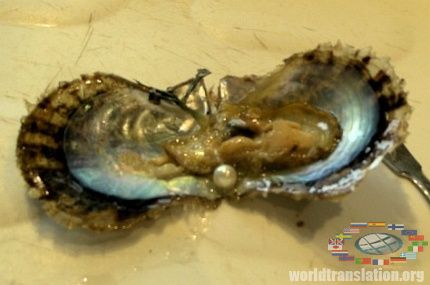 Pearl is the result of a protective mechanism of molluscs. When a foreign element - be it food, a parasite, a piece of shell or sand - gets stuck in the inner vulnerable cavity of mollusk, the object covers with a substances which are called aragonite and conchiolin. Over time, the layer of this sediments becomes thicker, forming a pearl of circular or other shape.
Pearl is the result of a protective mechanism of molluscs. When a foreign element - be it food, a parasite, a piece of shell or sand - gets stuck in the inner vulnerable cavity of mollusk, the object covers with a substances which are called aragonite and conchiolin. Over time, the layer of this sediments becomes thicker, forming a pearl of circular or other shape.
Formation of nacre.
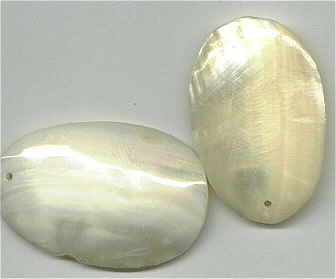 Aragonite - a form of calcium carbonate, and is a flat layer of crystals of hexagonal shape. Between the layers of aragonite lies formed by membrane layer of protein - conchiolin. However, aragonite and conchiolin form what is commonly called " nacre" - a brilliant cover of the inner surface of the clam shell. Aragonite reflects the light in unique way, thanks to its crystal structure, in which the sharp aragonite crystals are perpendicular to the surface of the pearl. That is why the pearl possesses its own characteristic brilliance.
Aragonite - a form of calcium carbonate, and is a flat layer of crystals of hexagonal shape. Between the layers of aragonite lies formed by membrane layer of protein - conchiolin. However, aragonite and conchiolin form what is commonly called " nacre" - a brilliant cover of the inner surface of the clam shell. Aragonite reflects the light in unique way, thanks to its crystal structure, in which the sharp aragonite crystals are perpendicular to the surface of the pearl. That is why the pearl possesses its own characteristic brilliance.
Natural and cultivated pearls.
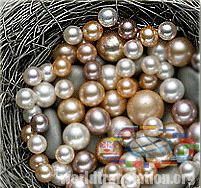 Pearls are formed naturally, but this happens rarely. In addition, natural pearls usually have irregular shape and small size, since mollusk only need to cover a foreign object, and not a perfectly round pearl. The shape of a pearl depends on the shape and size of the object, and with how even layer mollusk will cover it. Most of the pearls, which now are used by jewelers, are cultivated, ie produced with human intervention. Cultivated pearl is obtained when a foreign object is artificially inserted into the mollusk (usually pearl oyster), to force mollusk to cover the object with nacre. Over time, the producers of pearls have noticed that when they transplanted a piece of the oyster mantle of the shell itself into a ball from the sink, and then insert this in oyster gonad, they get a high quality pearl.
Pearls are formed naturally, but this happens rarely. In addition, natural pearls usually have irregular shape and small size, since mollusk only need to cover a foreign object, and not a perfectly round pearl. The shape of a pearl depends on the shape and size of the object, and with how even layer mollusk will cover it. Most of the pearls, which now are used by jewelers, are cultivated, ie produced with human intervention. Cultivated pearl is obtained when a foreign object is artificially inserted into the mollusk (usually pearl oyster), to force mollusk to cover the object with nacre. Over time, the producers of pearls have noticed that when they transplanted a piece of the oyster mantle of the shell itself into a ball from the sink, and then insert this in oyster gonad, they get a high quality pearl.
Varieties.
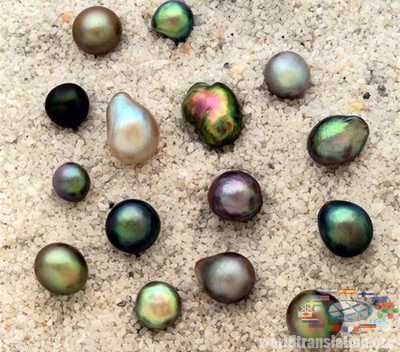 Pearls can look very different, depending on how they ware formed. Pearls can be: shiny white, more dull porcelain-white, pink, black and bronze. For example, the crystal structure of galiotis pearls, resembles a honeycomb, which leads to an unusual appearance. Black Pearl is one of the most appreciating pearls today, is a rare combination of bright colors and gloss. Pearl "Hope" is one of the largest natural pearls (450 carats), it changes color from bronze to white. Most likely it is a blister pearl. Blister pearls are obtained when a foreign object is pasted to shuck. Then only the open part of the object is covered with nacre.
Pearls can look very different, depending on how they ware formed. Pearls can be: shiny white, more dull porcelain-white, pink, black and bronze. For example, the crystal structure of galiotis pearls, resembles a honeycomb, which leads to an unusual appearance. Black Pearl is one of the most appreciating pearls today, is a rare combination of bright colors and gloss. Pearl "Hope" is one of the largest natural pearls (450 carats), it changes color from bronze to white. Most likely it is a blister pearl. Blister pearls are obtained when a foreign object is pasted to shuck. Then only the open part of the object is covered with nacre.
Symbol of luxury.
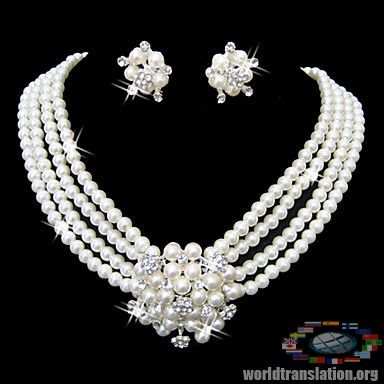 Thousand years pearl was a sign of wealth and high status in society, because for the natural formation of pearls of the ideal form was required the successful combination of many factors, which happens very rarely. Archaeologists have found the treasure of the ancient Egyptians, filled with pearls, wich indicating on the wealth of their owner. All over the world pearl is a symbol of abundance and beauty - from the Pacific Region to Asia and the Middle East. Even today, large pearls of good shape, especially the natural pearls are highly valued and are expensive, due to their beauty and rarity.
Thousand years pearl was a sign of wealth and high status in society, because for the natural formation of pearls of the ideal form was required the successful combination of many factors, which happens very rarely. Archaeologists have found the treasure of the ancient Egyptians, filled with pearls, wich indicating on the wealth of their owner. All over the world pearl is a symbol of abundance and beauty - from the Pacific Region to Asia and the Middle East. Even today, large pearls of good shape, especially the natural pearls are highly valued and are expensive, due to their beauty and rarity.